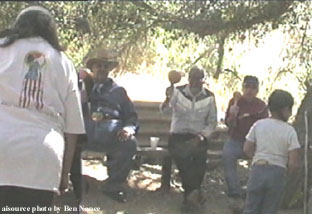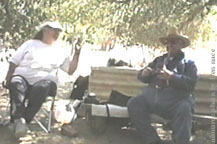San
Jose de Tecate: Traditions Under the Oaks
By Roy Cook
Auka. September 20, 2003, is a misty, foggy Southern California morning. Another opportunity beckons us to sing Nyemii Wildcat songs with our teacher Jon Meza Cuero. We are going to meet him in Tecate and shuttle over to San Jose de Tecate. As we, Ben Nance and myself, drive further south from San Diego, CA we crest small hills and drop down into swirling mist and vapor. There is an enveloping feeling of movement and travel back into history. Constant vistas of the Wildcat song cycle and the journey described in the song are all around us. We have been looking forward to this trip for some years. We are invited to attend as support singers and be a part of the gathering. This gathering is held at San Jose de Tecate. General directions to the gathering are: from San Diego, take Highway 94 east to Highway 188 south to Tecate, then cross into Baja and Tecate, Mexico then go east out of town, towards Mexicali on Highway 2.

Realizations of responsibility and unmet expectations have brought the Kumeyaay Elders together this beautiful day, Saturday 20, 2003, at 10:00 AM, in Tecate, Baja California, Mexico. There have been many attempts and disappointments in the past three hundred years of European and domestic colonialism. Today is a new day and all feel it may be the hopeful start to a more positive profile and increased self esteem in many sectors: Cultural, Language, Arts, and most significantly restoration of traditional cultural sovereignty amongst the Tribal Kumeyaay in Baja and the Kumeyaay of San Diego and Imperial Co.

![]() Geographically,
Tecate peak is due west of the San Jose community and Tecate, Mexico.
This mountaintop is known in Tipai as Kuchamaa or "exalted high place."
In 1992, it was named to the USA National Register of Historic Places.
It is not the geography but the Tipai people that have brought us to this
gathering. Many have long felt that something must be done to generate
a new awareness of the Tipai culture, language, education, water rights
and Indian cemeteries. The Tribal people come together in a traditional
way and represent their cultural heritage. Native speakers of Tipai speak
their tribal language as they have for millenniums. It is evident that
the traditional songs that are sung on this special occasion fulfill the
community’s expectations. Realizations of responsibility and unmet expectations
have brought the Kumeyaay Elders together this beautiful day in Tecate,
Baja California, Mexico.
Geographically,
Tecate peak is due west of the San Jose community and Tecate, Mexico.
This mountaintop is known in Tipai as Kuchamaa or "exalted high place."
In 1992, it was named to the USA National Register of Historic Places.
It is not the geography but the Tipai people that have brought us to this
gathering. Many have long felt that something must be done to generate
a new awareness of the Tipai culture, language, education, water rights
and Indian cemeteries. The Tribal people come together in a traditional
way and represent their cultural heritage. Native speakers of Tipai speak
their tribal language as they have for millenniums. It is evident that
the traditional songs that are sung on this special occasion fulfill the
community’s expectations. Realizations of responsibility and unmet expectations
have brought the Kumeyaay Elders together this beautiful day in Tecate,
Baja California, Mexico.
There have been many attempts and disappointments in the past three hundred
years of European and domestic colonialism. Today is a new day and all
feel it may be the hopeful start to a more positive Tribal profile and
increased self esteem in many sectors: Cultural, Language, Arts, and most
significantly restoration of traditional cultural sovereignty amongst
the Tribal Kumeyaay in Baja and the Kumeyaay of San Diego and Imperial
Co.
 |
Sitting here, under
a large oak, listening to the Tipai language spoken as the original American
language of the First Americans, brings back memories of other meetings
under oaks on the Santa Ysabel reservation. 
Lessons learned at the side of my childhood mentor, Steve Ponchetti, reemerge
when in traditional surroundings. This Tribal oral history is the responsibility
and heritage of the Kumeyaay Elders, tribal wisdom keepers. These elders
recognize that the hope of there tribal future is in the future generations.
The Kumeyaay Elders hold the heritage alive in the oral tradition and
the songs and ceremonies that define this International Culture. In attendance
are: Julia Meza Thing, cousin to Jane Dumas, Guadalupe Osuna, daughter
of Delfina Cuero, Maria de Jesus Meza Thing, sister of Julia Meza Thing,
Maria Francisca Meza Thing, sister of Julia Meza Thing, Maria Elena Meza
Lopez, daughter of Maria Francisca, Josefina Lopez, chairperson of Pena
Blanca and Juan Carrancio, traditional singer, Laura Cota Lopez, grand
daughter of Maria Francisca, director of Proyecto Paz y Dignidad, A.C.
Peace & Dignity Project's sister organization in Mexico, Proyecto Paz
y Dignidad, is assisting the San Jose de Tecate community in organizing
resources for the preservation and survival of Kumeyaay cultural and spiritual
traditions. We look forward to our next gathering on October 25, 2003
and more Niemii singing!
americanindiansouurce.com
Roy Cook: writer, public relations, speaker
Opata/Osage-Mazopioye Wichasha
WebMaster: Ben Nance
San Jose de Tecate:
Tradiciones Debajo de los Robles
de Roy Cook
Auka. 20 de septiembre
de 2003, es una mañana meridional misty, brumosa de California. Otra oportunidad
nos hace señas para cantar a Nyemii canciones gato con nuestro profesor
Jon Meza Cuero. Vamos a resolver lo en Tecate y la lanzadera encima a
San Jose de Tecate. Como nosotros, Ben Nance y mismo, sur adicional de
San Diego, CA de la impulsión nosotros crest las colinas pequeñas y gota
abajo en la niebla y el vapor que remolinan. Hay una sensación de la envoltura
del movimiento y del recorrido nuevamente dentro de historia. Los vistas
constantes del ciclo gato de la canción y del viaje descritos en la canción
están todo alrededor de nosotros. Hemos estado mirando adelante a este
viaje por algunos años. A nos invitan que atendamos como cantantes de
la ayuda y seamos una parte de la reunión. Esta reunión se lleva a cabo
en San Jose de Tecate.
Geográficamente, el pico de Tecate está derecho al oeste de la comunidad
y del Tecate, México del San Jose. Este mountaintop se conoce en Tipai
como Kuchamaa o "exalted el alto lugar." En 1992, fue nombrado al registro
nacional de los E.E.U.U. de lugares históricos. Es no el geografía sino
la gente de Tipai que nos ha traído a esta reunión. Muchos tienen fieltro
largo que algo se deba hacer para generar un nuevo conocimiento de la
cultura de Tipai, de la lengua, de la educación, de las derechas del agua
y de los cementerios indios. La gente tribal viene junta de una manera
tradicional y representa su patrimonio cultural. Los nativos de Tipai
hablan su lengua tribal como tienen por milenios. Es evidente que las
canciones tradicionales que se cantan en esta ocasión especial satisfacen
las expectativas de la comunidad.
Las realizaciones
de las expectativas de la responsabilidad y del unmet han traído a ancianos
de Kumeyaay juntas este día hermoso en Tecate, Baja California, México.
Ha habido muchas tentativas y decepciones en los últimos trescientos años
del colonialismo europeo y doméstico. Hoy es un nuevo día y toda la sensación
que puede ser el comienzo esperanzado a un perfil tribal más positivo
y a una estima creciente del uno mismo en muchos sectores: Cultural, lengua,
artes, y lo más perceptiblemente posible restauración de la soberanía
cultural tradicional entre el Kumeyaay tribal en Baja y el Kumeyaay de
San Diego y del Co imperial. Las direcciones generales a la reunión son:
de San Diego, la carretera 94 de la toma del este a la carretera 188 del
sur a Tecate, entonces se cruza en Baja y Tecate, México entonces va al
este de ciudad, hacia Mexicali en la carretera 2.
El sentarse aquí, debajo de un roble grande, escuchando la lengua de Tipai
hablada como la lengua americana original de los primeros americanos,
trae detrás memorias de otras reuniones debajo de robles en la reservación
de Santa Ysabel. Las lecciones aprendieron en el lado de mi mentor de
la niñez, Steve Ponchetti, reemerge cuando en alrededores tradicionales.
Esta historia oral tribal es la responsabilidad y la herencia de las ancianos
de Kumeyaay, encargados tribales de la sabiduría. Estas ancianos reconocen
que la esperanza del futuro allí tribal está en las generaciones futuras.
Las ancianos de Kumeyaay llevan a cabo la herencia viva en la tradición oral y las canciones y las ceremonias que definen esta cultura internacional. En la atención esté: Cosa de Julia Meza, primo a Jane Dumas, Guadalupe Osuna, hija de Delfina Cuero, cosa de Maria de Jesús Meza, hermana de la cosa de Julia Meza, cosa de Maria Francisca Meza, hermana de la cosa de Julia Meza, Maria Elena Meza Lopez, hija de Maria Francisca, Josefina Lopez, presidente de Pena Blanca y de Juan Carrancio, cantante tradicional, Laura Cota Lopez, hija magnífica de Maria Francisca, director de Proyecto Paz y Dignidad, CA.
La organización de la hermana del proyecto de la paz y de la dignidad en México, Proyecto Paz y Dignidad, está asistiendo a la comunidad de San Jose de Tecate en los recursos de organización para la preservación y la supervivencia de las tradiciones culturales y espirituales de Kumeyaay. ¡Miramos adelante a nuestra reunión siguiente de Octubre el 25, el 2003 y más cantar de Niemii!